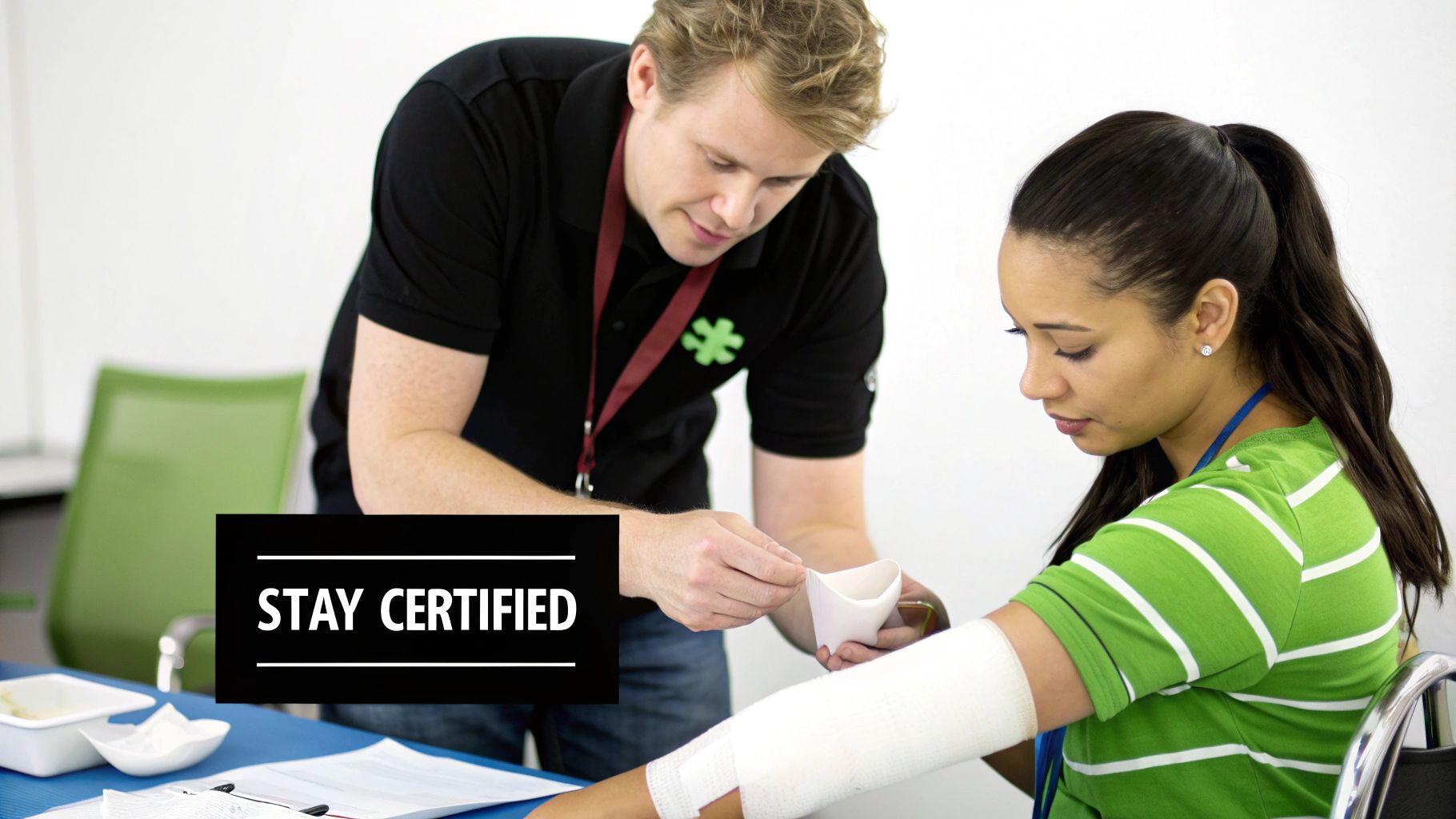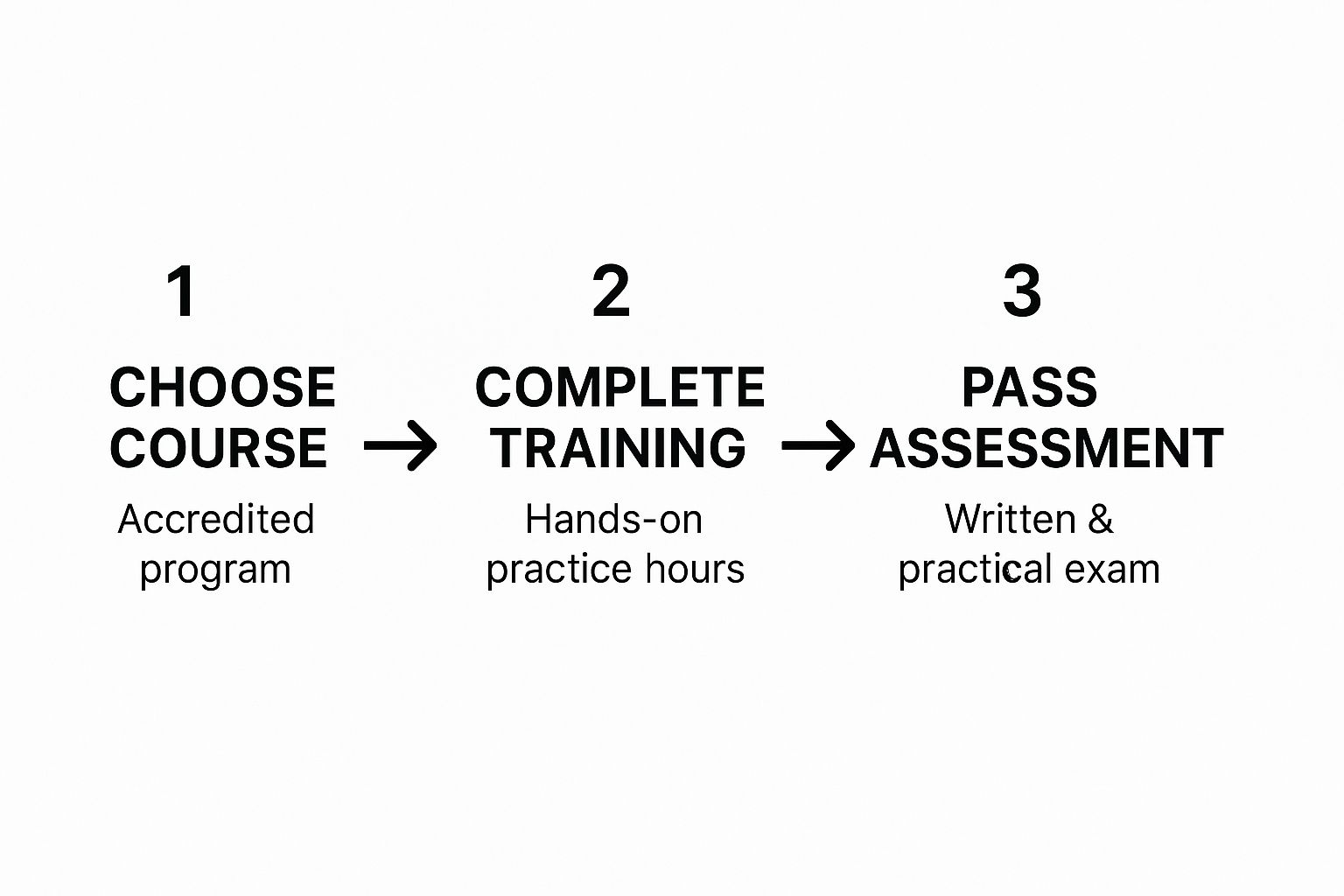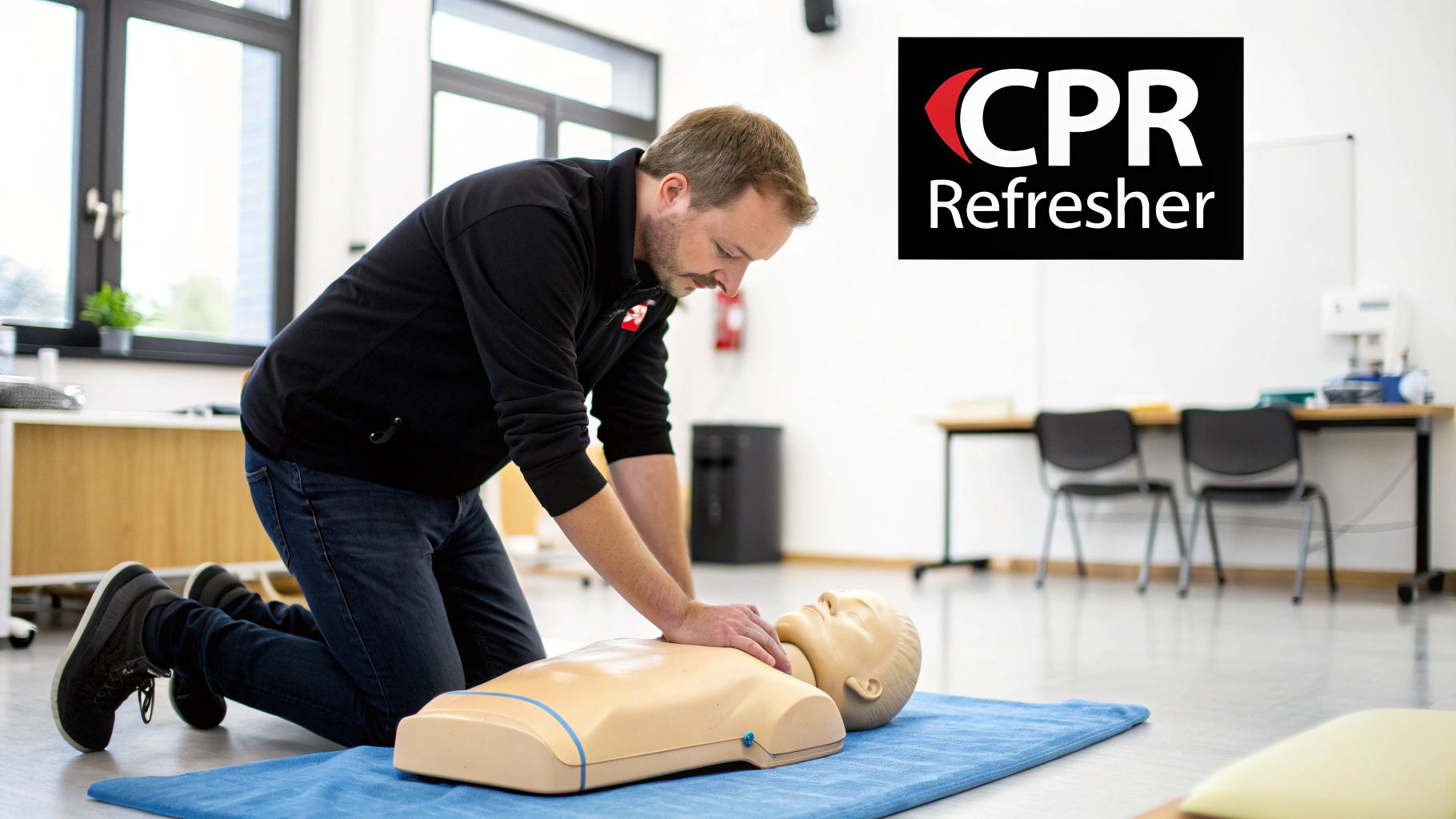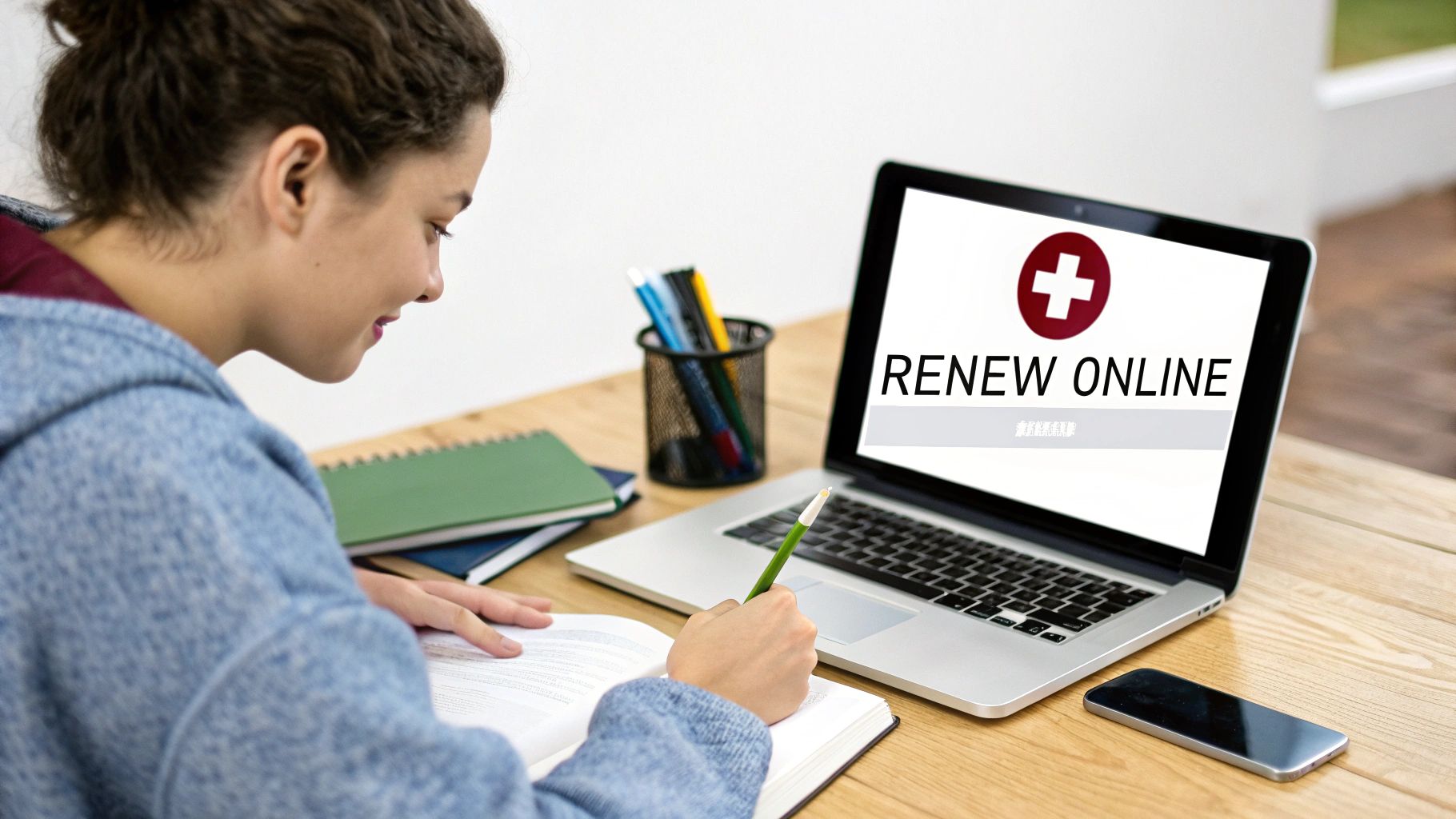That two-year mark on your first aid card can really sneak up on you. Renewing your certification is more than just a requirement—it’s a critical refresh of life-saving skills. This isn’t about just checking a box; it’s about making sure you can act confidently and correctly when every single second counts.
Why Renewing Your First Aid Skills Is Crucial
Think of first aid knowledge like any other hands-on skill. If you don’t use it, you start to lose it. A first aid recertification course isn't about re-learning everything from the ground up. Instead, it’s a fast-paced, focused session designed to sharpen your existing abilities and get you up to speed on the latest life-saving protocols.

Let's be honest, recalling every single step of CPR or how to properly use an AED under the immense pressure of a real emergency is a tall order. Regular training builds that crucial muscle memory, which is what transforms hesitation into decisive action.
Keeping Pace with Evolving Standards
Emergency medicine is always advancing, thanks to new research and real-world data. The techniques that were considered best practice just a couple of years ago might have been refined or even replaced. For example, guidelines for treating severe bleeding or responding to anaphylaxis have seen significant updates in recent years.
A recertification course ensures you're aligned with the current, most effective methods, not the ones you vaguely remember from your initial class. This alignment can directly impact a person's chance of survival.
This is exactly why organizations like the American Heart Association and the Red Cross recommend renewal. CPR and first aid certifications typically remain valid for two years. After that, recertification is a must to keep your skills current with the newest guidelines. The constant evolution of emergency protocols, driven by new medical research, directly leads to better patient outcomes and higher survival rates.
Building Confidence and Reducing Hesitation
One of the biggest hurdles in an emergency isn't a lack of knowledge—it's the fear of doing something wrong. This "analysis paralysis" can waste precious seconds when they matter most. A huge benefit of renewal is rebuilding your confidence so you can act without second-guessing yourself.
Here’s how recertification gets you there:
- Hands-On Practice: You get to physically practice on manikins, reinforcing the correct depth and rate for chest compressions until it feels like second nature.
- Scenario-Based Learning: You'll walk through realistic emergency situations, helping you practice assessing a scene and prioritizing your actions just like you would in a real event.
- Instructor Feedback: You receive immediate, expert feedback to correct your technique and answer any of those lingering questions you might have.
By consistently refreshing these skills, you're not just renewing a card; you're renewing your readiness to act. This proactive approach is essential for anyone in a caregiving or leadership role, from teachers and coaches to workplace safety managers. If you're looking for more info on the renewal process, check out our detailed guide on CPR and first aid renewal. It’s packed with insights to help you prepare. Your updated skills and renewed confidence don't just make you an asset—they make you a prepared and effective first responder.
Choosing the Right Recertification Course for You
Feeling a bit lost in the sea of first aid recertification options? You're not alone. Picking the right course can feel overwhelming, but it really boils down to your learning style, your schedule, and what your employer actually requires. Let's cut through the noise and figure out which format is the perfect fit.
The options generally fall into three buckets: fully in-person, fully online, or a blended model that mixes both. Each comes with its own set of pros and cons. The best choice isn’t always the most obvious one—it’s about finding that sweet spot between convenience and the quality hands-on practice you need to feel confident in an emergency.
Getting this right matters. The global first aid training market was valued at around USD 4.81 billion in 2023 and is expected to climb to nearly USD 7.69 billion by 2032. This boom is driven by stricter workplace safety rules and a growing public awareness of the need for qualified first responders, making a legitimate, recognized certification absolutely essential.
In-Person vs. Blended vs. Online Courses
So, what’s the real difference between these formats, and which one should you pick?
Fully In-Person: This is your traditional classroom setting. It’s fantastic for learners who thrive on direct interaction, asking questions in the moment, and getting immediate feedback on their technique. The downside? It requires a dedicated block of time and is easily the least flexible option.
Fully Online: These courses offer maximum flexibility—you can chip away at the material anytime, anywhere. But here's the catch: they completely lack the critical hands-on component. Because of this, many employers, especially those regulated by OSHA, will not accept online-only certificates.
Blended Learning: This is often the gold standard for busy professionals. You complete the knowledge portion online at your own pace and then attend a short, in-person skills session to practice with an instructor. It really is the best of both worlds, balancing convenience with the essential hands-on practice needed to build real confidence and competence.
At Ready Response, we champion the blended learning model. We've seen firsthand how it allows professionals to fit crucial training into their busy lives without ever sacrificing the quality of their skills.
To help you decide, here’s a quick breakdown of the different recertification course formats. This table can help you match a course style to your learning preferences, schedule, and certification needs.
First Aid Recertification Course Format Comparison
Ultimately, the best format ensures you not only get a valid certificate but also walk away feeling truly prepared to act.

As you can see, a valid recertification process always starts with an accredited program and requires you to pass both a written and a practical exam.
How to Vet a Training Provider
Not all certifications are created equal. To make sure your certificate will be accepted and that you're actually getting high-quality training, you need to vet your provider carefully. It’s a step too many people skip.
Here’s a practical checklist to run through before you book anything:
- Check for Accreditation: Does the provider offer courses certified by a nationally recognized body like the American Heart Association (AHA) or the American Red Cross? For most employers, this is non-negotiable.
- Ask About Instructor Experience: Are the instructors experienced paramedics, nurses, or EMTs? Instructors with real-world field experience can offer insights and context that make a huge difference in your training.
- Inquire About Equipment: Will you be practicing on modern, well-maintained manikins (including infant models) and AED trainers? You can't build muscle memory on outdated or broken equipment.
- Confirm CPR is Included: First aid and CPR go hand-in-hand. When looking at recertification, consider courses that bundle them. You can often sign up for a CPR class that covers all the bases.
- Read Reviews: What are past students saying? Look for specific comments on class size, instructor engagement, and the overall learning environment.
Making the right choice here is a lot like the process we outline in our guide on choosing the right CPR course, where legitimacy and hands-on practice are the most important factors.
By asking these simple questions upfront, you can confidently choose a provider that delivers valuable, compliant training that will leave you feeling prepared for a real emergency.
What to Expect During Your Recertification Class
Walking into a first aid recertification class can feel a little like you're about to take a pop quiz, especially if it’s been a couple of years since your last one. But here's the good news: these courses are designed as fast-paced refreshers, not as if you're learning everything from scratch. The real goal is to sharpen the skills you already have and build on that foundation.

Expect the session to move pretty quickly. Unlike your initial certification, where a good chunk of time is spent on theory, a recertification class jumps right into the practical stuff. Your instructor knows you've been through this before, so the focus is all on practice, fine-tuning your technique, and getting you up to speed on any recent protocol changes.
A Typical Class Agenda
Most recertification classes, particularly the blended learning skills sessions, follow a pretty dynamic but structured format. An instructor usually kicks things off with a quick review of the key principles before getting you right into the hands-on practice.
Here’s what you can generally expect to cover:
- Scene Safety and Assessment: This is always the first step. You'll do a quick but vital review of how to size up an emergency scene before you even think about approaching a victim.
- CPR and AED Practice: This is the heart of the class, no pun intended. You'll spend most of your time on the manikins, practicing chest compressions and rescue breaths. The instructor will be there to give you direct feedback on your rate, depth, and recoil to make sure your technique is spot-on.
- Choking Response: You'll go over the procedures for both conscious and unconscious choking victims, covering adults, children, and infants.
- Major Medical Emergencies: This part of the class revisits how to respond to common, critical situations like severe bleeding, shock, seizures, and anaphylaxis.
Don’t be surprised if the instructor throws a few curveballs with some realistic scenarios. They aren't trying to trip you up. The idea is to make you think critically under pressure, just like you’d have to in a real emergency. That kind of active problem-solving is what makes the skills really stick.
Pro Tips for Success
A little bit of prep can go a long way in helping you get the most out of your session and walk out feeling confident. This isn't about cramming for a test; it’s about setting yourself up to learn effectively.
Before you show up, think about these tips:
- Do a Quick Review: If you did an online module, quickly skim the key takeaways. If not, even watching a five-minute video on CPR basics can help jog your memory. Taking this small step helps you focus on refining your skills instead of just trying to recall them.
- Wear Comfortable Clothes: This is a big one. You'll be on your knees practicing CPR, moving around, and maybe even simulating different emergency positions. Athletic wear or anything you can move in easily is your best friend here.
- Come Ready to Engage: Ask questions! If there’s a skill you feel a bit rusty on, now is the time to speak up. A great instructor wants you to leave feeling 100% prepared and confident.
Knowing what’s coming helps replace any anxiety with confidence. The session is really designed for your success. For more specifics on what these essential skills involve, our guide to the First Aid Heartsaver course has you covered.
Avoiding Common Recertification Mistakes
Even seasoned first responders can run into a few snags with their first aid recertification. A handful of common, and totally avoidable, mistakes can cause a lot of unnecessary stress, cost you extra money, or even leave you with a temporary gap in your certification. Knowing what to watch out for ahead of time is the best way to make sure your renewal is smooth and successful.
The single biggest mistake? Letting their certification lapse entirely. It happens more often than you'd think. Life gets hectic, that expiration date on your card slips your mind, and suddenly you’re outside the renewal window.
When that happens, you usually can’t just sign up for a quick refresher course. Most certifying bodies will require you to take the full, time-consuming initial certification course all over again.
Think of it like your driver's license. If you let it expire for too long, you can't just hop online to renew it; you have to go back to the DMV and retake the tests. The same idea applies here, turning a simple task into a major headache.
Dodging Certification Mills and Other Pitfalls
Another major risk is getting duped by a non-accredited "certification mill." These are often online-only programs that promise fast, cheap certification but aren't recognized by major bodies like OSHA or accepted by most employers. You might pay for the course and get a certificate, only to find out it’s completely worthless for your job.
To keep your recertification on track and stress-free, here are some common missteps and how to sidestep them:
Forgetting the Expiration Date: This is, without a doubt, the most frequent problem.
- The Fix: As soon as you get your new card, pull out your phone and set a calendar reminder for 90 days before it expires. This gives you a generous buffer to find and schedule a class without any last-minute panic.
Choosing a Non-Accredited Provider: Falling for a "too good to be true" online-only course is a costly error.
- The Fix: Always, always verify that your training provider is certified by a nationally recognized organization like the American Heart Association (AHA) or the American Red Cross. Reputable providers, like Ready Response, guarantee their courses meet these standards.
Assuming You'll Pass Without Practice: Your skills will get rusty. Showing up to a recertification class without having thought about CPR or first aid for two years can make the hands-on assessment feel surprisingly tough. While courses are designed to help you succeed, being unprepared can crank up the anxiety.
- The Fix: Just spend 15-20 minutes the week before your class watching a few refresher videos on key skills like chest compressions and AED use. For anyone worried about the testing part, understanding the common reasons people might fail a CPR course can help you prepare effectively and walk in with confidence.
Keeping Your First Aid Skills Sharp Year-Round
Earning your first aid recertification is a huge accomplishment. But let's be real—that certificate on the wall doesn't do much good if the skills behind it have gone rusty. True readiness isn't about cramming for a test every two years; it’s about keeping your knowledge fresh and your confidence high so you can act when seconds count.
The good news? Staying sharp doesn't mean you have to carve out huge chunks of your time.

Small, consistent efforts are way more effective for long-term skill retention than letting two years slip by without a single thought about first aid. Think of it like light maintenance for your life-saving abilities.
Practical Ways to Keep Your Skills Fresh
Weaving quick, low-effort refreshers into your routine can make all the difference. You don't need to block out hours on your calendar. Instead, try folding these simple habits into your life.
- Watch Refresher Videos: Spend five minutes watching a quick video from a trusted source like the American Heart Association or Red Cross. Focus on just one skill, like the right hand placement for CPR or the steps for using an EpiPen.
- Use First Aid Apps: Download a reputable first aid app on your phone. Many have short quizzes or run through different scenarios, which you can easily do while waiting in line for coffee. It’s a simple way to test your knowledge on the go.
- Mentally Rehearse Scenarios: This is something you can do absolutely anywhere. If you're at the grocery store or a park, just take a moment to look around and think, "What would I do if someone collapsed right here?" Walk yourself through the steps: check the scene for safety, call for help, begin your assessment. This simple exercise keeps your response protocols right at the front of your mind.
This kind of continuous engagement is critical, especially when you realize how few people have this training. Globally, the prevalence of CPR training varies a lot, but a global CPR training prevalence study found that the median is only about 40% of people having ever received it. That data really highlights why those of us with training need to stay ready.
Create Opportunities to Practice
Going beyond solo refreshers, actively looking for real-world practice opportunities will solidify your skills like nothing else. These situations are what turn theoretical knowledge into pure, practical confidence.
The goal isn’t just to know what to do; it’s to build the instinct to act correctly and without hesitation. Consistent practice is what builds that instinct.
Think about getting involved in ways that naturally put your training to use:
- Take workplace safety drills seriously. Don't just go through the motions. Treat every single drill like a genuine chance to practice your response.
- Volunteer at community events. Local festivals, 5K runs, or sporting events often need first aid volunteers. It’s a great, low-stakes environment to stay vigilant and prepared.
These small, proactive steps are what transform your certification from a piece of paper into a state of genuine readiness. If you're looking to build that strong foundation from the start, our guide on getting your CPR and AED certification covers the core skills you'll want to keep sharp.
At the end of the day, keeping your skills honed year-round ensures you’re not just certified—you’re truly prepared to help when it matters most.
Your First Aid Recertification Questions Answered
Even after mapping out the process, you probably still have a few lingering questions. That's completely normal. We hear the same handful of practical questions from professionals all the time, so let's get those cleared up right now.
Think of this as your final check-in before you commit. We'll dive into the nitty-gritty details to make sure you're feeling confident and ready to go.
How Long Is My First Aid Recertification Valid?
This is a big one. Nearly all accredited first aid and CPR/AED certifications, including those from the American Heart Association and the American Red Cross, are valid for two years.
That two-year mark isn't just a random date—it’s the industry standard. It’s set to ensure your skills stay fresh and align with the most current medical science and life-saving protocols. Letting this date slide is a non-starter for most jobs, as continuous compliance is almost always a requirement.
Can I Do My Entire First Aid Recertification Online?
You’ll see plenty of "100% online" courses advertised, but here’s the reality: most employers and regulatory bodies won’t accept them. They require a hands-on skills assessment to prove you can actually perform the techniques when it counts. A certificate from an online-only provider often gets rejected for workplace compliance.
This is exactly why blended learning has become the go-to for so many busy professionals.
It's truly the best of both worlds. You can knock out the classroom portion online, whenever it fits your schedule, then come in for a short, focused in-person session to practice with a certified instructor. Always, always check with your employer about their specific rules before you sign up.
What Happens If My First Aid Certification Expires?
Let your certification lapse, and you’ll almost certainly have to take the full, initial certification course all over again. The shorter, faster-paced recertification class is off the table. While a few providers might offer a grace period of around 30 days, you can't count on it.
The initial course is longer, more in-depth, and more expensive. It just makes sense to get your recertification on the calendar well before your card is set to expire.
What Should I Bring to My In-Person Skills Session?
Good news—prepping for the hands-on part of your recertification is simple.
Here’s what you’ll want to have with you:
- Your certificate of completion from the online coursework (if you’re taking a blended course).
- A valid photo ID so we can verify it’s you.
- Comfortable clothes and shoes. You'll be moving around, kneeling, and practicing, so dress accordingly.
Your training provider will have all the gear—the manikins, AED trainers, and first aid supplies. I’d also suggest bringing a small notebook and pen. You never know when an instructor will share a powerful tip or a new guideline that you’ll want to remember.
At Ready Response, we work hard to make recertification as straightforward and effective as possible. Our accredited blended learning courses are built for professionals on the go, making sure you get the hands-on practice you need to feel confident and stay compliant. Find a class that works for you and renew your life-saving skills by visiting https://readyresponsepa.com.
